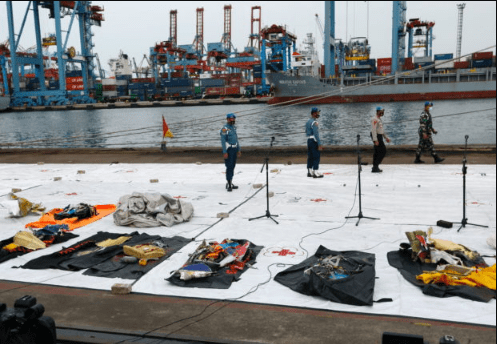Indonesia identified a victim from the Sriwijaya Air crash on Monday as emergency crews prepared to send in a remotely operated underwater vehicle to search for the jet’s cockpit recorders in the sea.
The Boeing 737-500 plane with 62 people on board plunged into the Java Sea two days ago, minutes after taking off from Jakarta’s main airport.
Divers scoured the sea bed on Monday, retrieving human remains, personal possessions and pieces of plane wreckage until fading light ended the search, emergency officials said.
Okky Bisma, a flight attendant on the plane, was identified by his fingerprints, a police official told reporters.
“The quicker we can find victims, the better,” search and rescue operation director Rasman MS said.
The Boeing 737-500 jet was headed on a domestic flight to Pontianak on Borneo island, about 740 km (460 miles) from Jakarta, on Saturday before it disappeared from radar screens.
It was the second major air crash in Indonesia since 189 passengers and crew were killed in 2018 when a Lion Air Boeing 737 MAX also plunged into the Java Sea soon after taking off. The jet that crashed on Saturday is a largely different design.
The search team had narrowed down the suspected location of the “black box” flight recorders and the remote-controlled vehicle would help scan the sea bed, navy chief of staff Yudo Margono said.
“There is so much debris down there and we have only lifted a few pieces. Hopefully, as we take out more they (the recorders) can be found,” Yudo told reporters aboard a ship.
Nurcahyo Utomo, an investigator at Indonesia’s National Transportation Safety Committee (KNKT), said the jet may have been intact before it hit the water, given the debris appeared to have scattered in a relatively tight area underwater.
Once the flight data and cockpit voice recorders are found, the KNKT expects to be able to read the information in three days, Nurcahyo said.
The U.S. National Transportation Safety Board will automatically be involved in the investigation, with technical support from Boeing as needed.
Tracking service Flightradar24 said the aircraft took off at 2:36 p.m. local time (0736 GMT) and climbed to 10,900 feet within four minutes. It then began a steep descent and stopped transmitting data 21 seconds later.
The Sriwijaya Air plane was nearly 27 years old, much older than Boeing’s problem-plagued 737 MAX model. Older 737 models are widely flown and do not have the stall-prevention system implicated in the MAX safety crisis.
With few immediate clues on what caused a catastrophic loss of control after take-off, investigators will rely heavily on retrieving the two flight recorders intact from the seabed.
They will also study maintenance and engine records, pilot rosters and training, air traffic recordings and other data.
Newer jets and their engines emit streams of data to help airlines plan maintenance. But neither the 737-500 nor its engines leave such a digital trace, industry experts say.
The crash comes at a sensitive time and place for Boeing after poor software contributed to crashes of the newer 737 MAX in Indonesia and Ethiopia. But the long service history of the model involved in Saturday’s crash, and its lack of similar software, mean design is seen less likely to be a primary focus.

